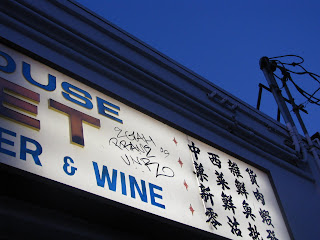
Just got back from the Hollywood Farmer's Market.
I have to say, compared to the markets in Watts and South Central, the Hollywood Farmer's Market is insane. The markets in Watts and South Central have two rows with maybe 8-10 vendors on each side of the row. Watts looks like this:

It was actually hilarious for me to upload the above photo now that I have been to the market in Hollywood. I'm not sure how I can make a comparison. Note above: few people, few booths, very small and not crowded at all. The Hollywood Farmer's Market is gigantic, it has 4 rows arranged in an X shape. I would estimate that there are hundreds of vendors. There are certainly a billion options, and it is totally mobbed. It is the kind of thing where you have to stay on the right side of the aisle and just accept that the flow of people shuffling their feet along (no way you could walk full stride) is just going to completely control your movement down the row. This picture doesn't really do it justice, but here you go:

I noticed right away that the Hollywood market seems expensive. This market had a ton of specialty prepared items to offer the higher income clientele. Think jars of mozzarella cheese floating in fresh herbs and gourmet olive oil, and $10 bags of pesto made from organic basil. You didn't see any of that stuff in Watts and South Central. Everything in the Hollywood market seemed to be organic though, and most vendors even had signs on the bins of produce saying "no sprays" or "pesticide free". I assume this is in response to a high demand for pesticide free food. In Watts and South Central I had to ask each farmer about their methods. There were no signs advertising "spray free" food. Is that because Farmer's Markets shoppers in Watts and South Central don't ask for that? Maybe.
Here is what I bought:
- 2 navel oranges at $1/lb = $2 * they were $3 for 5 lbs. in South Central
- 1 sweet onion at $1.50/lb = $1 * $1/lb in South Central
- a $1 bag of tomatoes (4) = $1
- a $1 bag of zucchini = $1
- 1 bunch of kale (seems smaller than the one I bought in Watts) = $1.50 *same price as Watts but I swear the bunch is smaller
- 1 generous head of cabbage = $1
- big bag of pesticide free carrots at $1/lb = $2
Total: $9.50
Remaining this week: $14.36
There were so many things at this market, but I stopped buying at $9.50. I was afraid that many produce items were simply too expensive. The things I bought were the only cheap options: carrots, cabbage, and some $1 discount bags which I was lucky to find. Other things just didn't seem worth it. For example, I could have bought a bunch of bok choy for $1 ($2 at some vendors' stalls), but the bunch was so small I was afraid it would only make one meal's worth of food. That would mean no left overs for lunch of dinner the following day. Such a meal would not be worth the time it took to cook it, let alone the price.
The value at this Farmer's Market was pretty weak. No bang for the buck it seemed. Most produce was over $1 per pound, sometimes as much as $3 per pound, and that is just really out of my price range. So, I went to this market and bought some of the foods I have read should be prioritized in Organic buying, such as zucchini and tomatoes. That is all well and good, but now I am going to have to take another shopping trip during the week because I could not afford to do all of my shopping at this market.
























